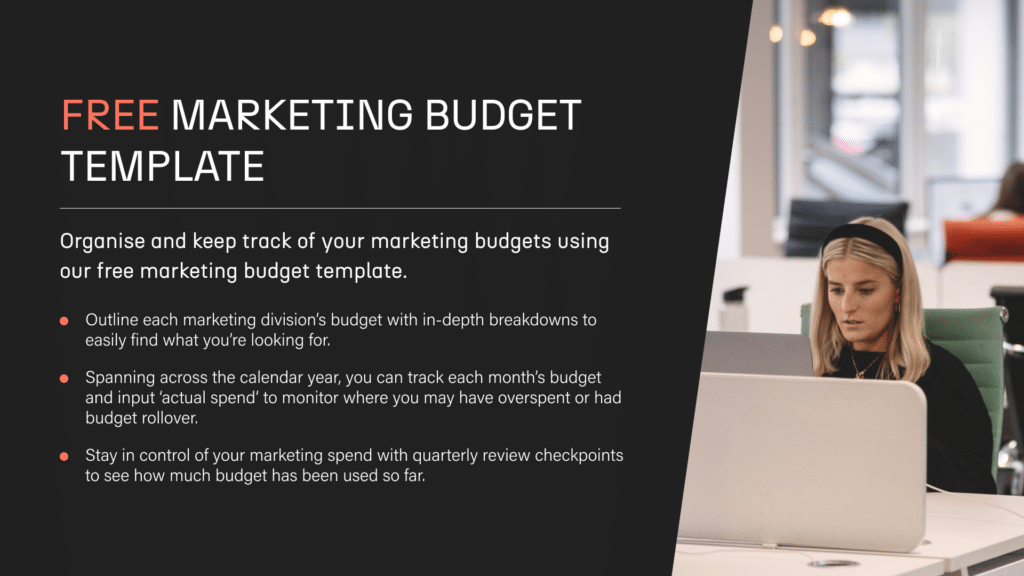How to Allocate a Digital Marketing Budget for Maximum ROI [With budget template]
In a perfect world, there’d be a one-size-fits-all budget that meant success across the board for all your digital marketing activity. Unfortunately, things aren’t quite as straightforward.
When it comes to allocating a budget to your strategy, there are a few things you have to weigh up. The nature of your business, its structure, objectives and sales funnel – to name but a few – will all need to be factored in before you land on a figure.
And since digital marketing can have a sizable hand in the success of a business nowadays, getting it right is vital. The good news is we know a thing or two about how to do that.
If putting money behind your marketing is something that’s proven tricky in the past, we’re here to help. Below, we’ll guide you through how to allocate a budget to your digital marketing efforts to maximise your ROI and get more bang for your buck going forward.
What is a digital marketing budget?
A digital marketing budget is the amount of money that a business allocates to the promotion of its goods or services across its digital channels. Usually developed on a quarterly or annual basis, such budgets should be detailed and in-depth, with both short-and long-term project plans accounted for.
What should a digital marketing budget include?
Your digital marketing budget should include all the costs that you’ll expect to pay for products and services you plan to use, whether they’re in-house or with an agency. Digital marketing covers plenty of ground, so your budget may include spend covering the likes of web design, email marketing, social media, paid media, content marketing and SEO.

How do you calculate a digital marketing budget?
It won’t surprise you to learn that there’s more to calculating your digital marketing budget than simply plucking a figure out of thin air. But if that’s the case, where exactly do you start?
There’s a tried-and-true rule of thumb that says you should spend between 7-10% of your overall revenue on marketing activities. This amount ensures you’re spending enough without going overboard.
From this number, about half or more should go towards digital marketing. Once you know which strategies you’ll be moving ahead with, you’ll then have to allocate money to each of these. Instead of simply going with your gut, ground these amounts in the 70-20-10 rule.
The 70-20-10 rule is an essential way of allocating your funds more effectively. When you break it down, it looks like the following:
- 70% should be spent on the strategies you know work well for your business
- 20% should be spent on the new strategies you’re intending to introduce to your business
- 10% should be spent on experimenting with emerging technology or strategies. This gives you a chance to stay ahead of the competition.
Best practices for allocating a digital marketing budget
Although the 70-20-10 rule helps with finding the percentage of overall revenue you’ll want to spend, narrowing down the focus will help to create a more detailed breakdown of your spending and activities.
The following best practices can guide you towards better digital marketing budget allocation.
Review your past results
“Those who cannot remember the past are condemned to repeat it.” It’s a lofty quote for an article about digital marketing, but it rings true. Casting an eye over your past results lets you know which strategies to push ahead with and which you may need to give up on.

Identify your costs
Part of creating a digital marketing budget is knowing which other areas of your business require financial input. In addition, you’ll need to know how much it’s going to cost to implement your chosen marketing strategies.
As such, you’ll need to consider the cost of things like bringing in extra people, campaign costs, and the price of website hosting.
Establish goals
What is it you want to achieve through digital marketing? Is it to bring in more leads? Are you looking to increase conversions? Or maybe it’s sales you’re looking to boost?
Once you have goals in place, it becomes far easier to identify the kinds of activities that are not only going to get you there but that can be achieved with the budget you have.
Here at Banc, clients often approach us with a channel solution or project in mind – whether that’s a content marketing plan, SEO campaign or website refresh. But the most valuable thing for us is to ask ‘why’ and question the brief, to get to the heart of the real business challenge at hand.
If goals and motivations are unclear or the outlook is complex, we recommend a discovery process, which involves undertaking customer research, internal exploration, and benchmarking competitor positioning. We do this to reveal opportunities which can be prioritised with digital marketing in order of opportunity, competition and priority.
Select the channels that work best
The array of channels you can use to broadcast your marketing initiatives can get a little daunting. But don’t be drawn into the idea that you have to use them just because others are.
What matters most is that you choose the channels that best suit your business and your budget.
The above best practices can guide you towards better digital marketing budget allocation– and so can our Marketing Budget Template, a handy downloadable resource you can use to keep track of all your costs, goals, and results.

How to get the most out of your digital marketing budget
Once your campaigns are up to speed, you’ll have a better idea of which are performing well, and which might be falling short.
Of course, what constitutes success will always be goal dependent. But there are frameworks which can help you make decisions around when might be the right time to invest further, or when it’s time to cut your losses and shift investment into other areas.
At Banc, we’re conscious of using our clients’ resource and budget in the right ways and at the right times. It’s also important that we approach this in a transparent way, too.
Often, we’ll create a working maturity model for our clients where different conditions and performance milestones have to be satisfied in order to enable movement to the next phase of a campaign.
This helps both us and our clients to understand where they are with their campaign efforts, what the next steps should be, and when the appropriate time to take them is. This also ensures that operational foundations are in place and that there is a strong baseline of activity to build from; a rounded approach which can be scaled off with specialised and more specific activity.
Basically, it’s a way of stopping us from getting ahead of ourselves.
We also use a “phased budget” approach. This means we use your budget in a way to maximise return in the first instance, before moving on to more sustainable ROI in the long term.
For example, through a phased paid/organic strategy, we’ll implement the paid activity first to grab some quick wins. With that ticking away in the background, we’ll put together a longer-term organic strategy for sustainable ROI long into the future.
In need of knowledge from a team of digital marketers who know their stuff? We’ll help you put your money in the right place so you can benefit from a proper ROI. Head to our homepage or drop us a line on 0345 459 0558 to get the ball rolling.



